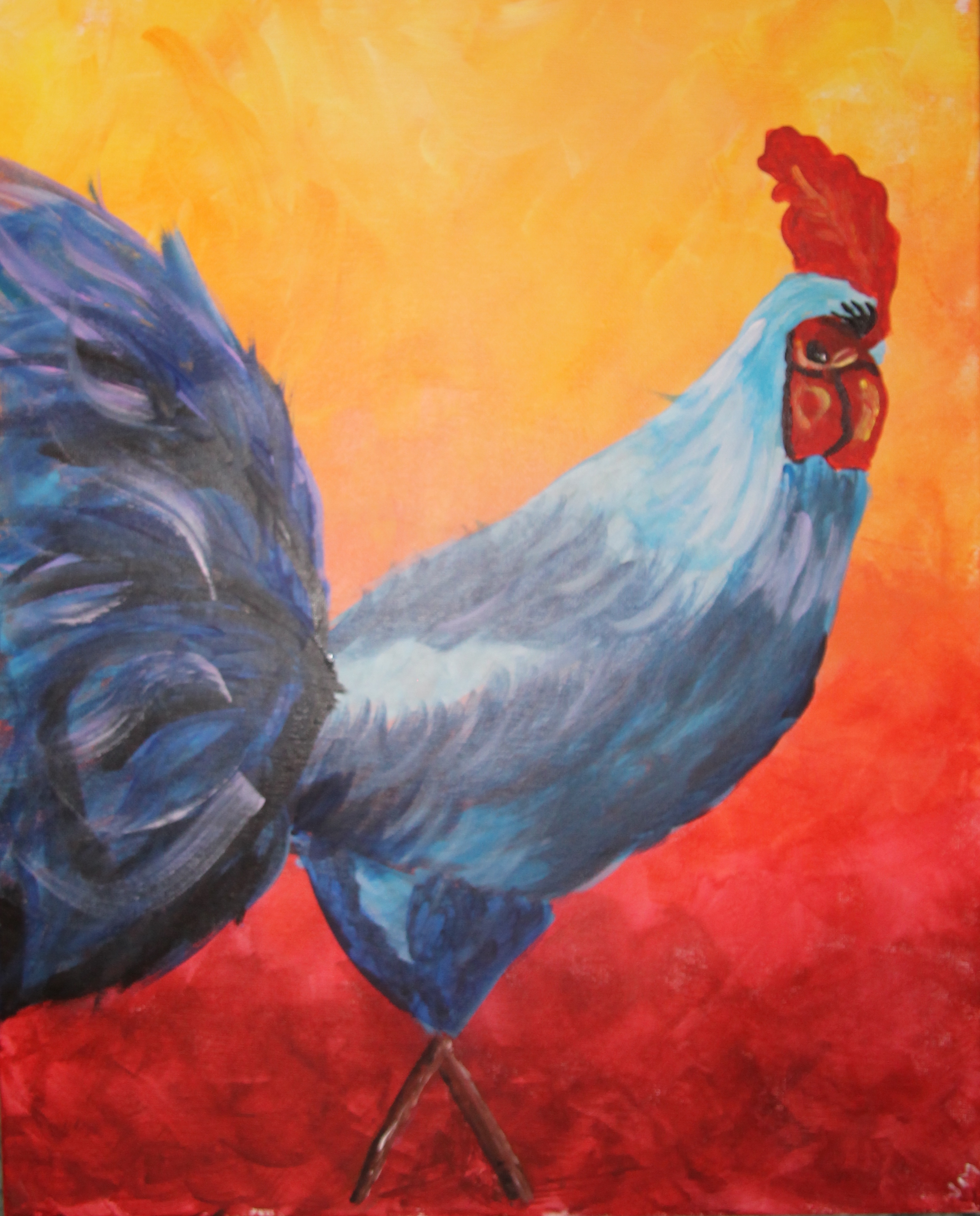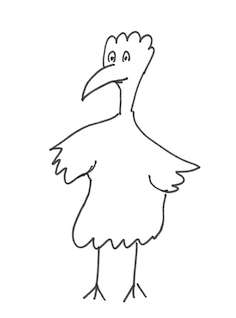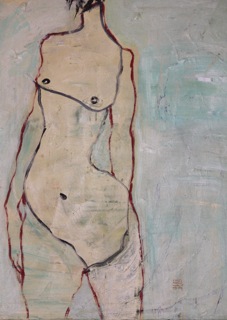
By Jody Mace
It’s been about two years since I decided I wanted to paint a chicken. Maybe three. It’s not the kind of thing I would have put on my calendar to fact-check later.
I was in a small restaurant in Chapel Hill, North Carolina. Its sign was topped with a huge, pink pig sculpture, but this was no barbecue joint. They did serve pork but with Madeira sauce and mashed rutabagas. They served some items that were good ideas, like jalapeno-cheddar hushpuppies, but also some items that seemed like bad ideas, like chicken and duck liver mousse. It was the kind of place where the wait-staff might indulge you if you asked what farm your quail came from, even if they didn’t know the answer.
The restaurant also served as exhibit space for local artists. Several paintings of chickens caught my eye. They weren’t folk-art chickens. They weren’t realistic renditions. They weren’t exactly whimsical. They were in that chicken sweet spot: colorful, not too silly, but also not taking themselves too seriously.
I don’t understand what makes me respond to certain artwork. Sometimes it seems like my brain is wired in a way to be receptive to a certain artist or musician and when I encounter that art at the right time it fits into my brain like a LEGO snapping into place. Looking at those chickens made me feel happy. Maybe it was as simple as that.
I texted my husband: “I have decided that I will paint chickens.”
Stan texted back something like “hahahaha.”
“I’m serious,” I texted. “I’m going to paint chickens.”
And I was serious. When I got home I reiterated that I planned to paint chickens and he asked a lot of questions. Too many questions. Questions like “Watercolor or acrylic?”
It was difficult for me to answer questions like that because I didn’t know anything about painting, so I couldn’t evaluate the pros and cons of watercolor versus acrylic paint.
He also tried to be helpful in other ways. Whenever he came upon a painting of a chicken (and, in all likelihood he was actually googling “chicken painting” because otherwise why would he even come across chicken paintings?), he’d text me the image and I’d text back “No, not that kind of chicken.”
All I knew was that I wanted to paint chickens like the ones in the paintings in that restaurant in Chapel Hill, but I couldn’t exactly remember what they looked like.
I talked about painting chickens a lot. When Stan, who actually can draw, would mention something he was planning to draw, I’d say “And I’m going to paint chickens.”
Our son was in the final stretch of high school. Sometimes we talked about what our lives would look like after he left for college, how we’d fill our time and find fulfillment.
“That’s when I’ll paint chickens,” I’d say.
I told my friends that I was going to paint chickens. Sometimes it took a minute before they understood that I meant I was going to paint pictures of chickens, not apply paint onto actual chickens. But, to be fair, both activities probably sounded equally improbable.
One thing that I did not do during my two or three years of wanting to paint a chicken was to actually try to paint a chicken.
The main thing stopping me was the fact that I’m not good at art. I have two pictures that I’ve repeatedly drawn since I was a child. One of them is a cartoon chicken. (The other is a frog playing the banjo.) I can draw it now, almost exactly the same way I drew it when I was twelve. And I was afraid that if I painted a chicken, no matter how I envisioned it when I started, it would end up looking like my standard chicken drawing.
This is the way I draw a chicken:
What scared me was failing. As long as I didn’t try to paint a chicken, I had something beautiful that was all mine—a dream of painting a chicken. But if I tried to paint it and hated the result, then not only would I not have a good chicken painting, but I also would no longer have the dream of painting a chicken.
But last week I came across a picture of a rooster on the website of a local painting studio. It was one of those studios where a whole class of people learns to paint the same picture, like maybe a beach, or a cactus, or the Eiffel Tower. I’ve always thought those classes were not teaching real art. Everyone’s paintings looked pretty much the same at the end. Where was the creativity?
On the other hand, this wasn’t a beach or cactus; it was a rooster. And the rooster reminded me a lot of the chickens I had seen years ago at that restaurant. If I could learn basic rooster-painting skills in this class, then I could go on to paint my own chickens or roosters.
I texted my husband that I was going to sign up for a rooster-painting class.
He texted back, “I can try to help you if you want.”
I replied, “Help me paint the chicken? Step by step?”
“There’s no step by step in art!”
“The studio I’m looking at does step-by-step instructions and two hours later you have a rooster.”
I signed up.
I told my friend Sharon that I was finally going to paint a rooster.
She asked, “Would it be too much pressure if I went too?”
I told her that it wouldn’t be too much pressure, but that she should know I wasn’t going there to socialize. I was going there to paint a rooster.
When I got to the studio, a yoga class was finishing up, which seemed like a good use of the space between painting sessions. I learned that the studio sold wine and beer to people who weren’t serious about painting roosters. I also learned that Sharon and I were the only two people in the rooster-painting class. I was happy about that because it meant I’d get a lot of individualized instruction.
Here’s how you paint a rooster:
You start with the background. You use a big brush, and paint Xs to get started. This is not precise work. You can think of it as an icebreaker, just to help get you acquainted with the paint and the canvas. As you go up on the canvas, mix a little white in with the paint to lighten it, and gradually blend it, so the bottom is darker and the top is lighter. You could stop right there, and it might look pretty, depending on what colors you chose, but you wouldn’t have a rooster.
Once you have the background painted, you draw the shape of the rooster with chalk. At this point I realized that I had very little idea of what shape a chicken was, despite having seen many chickens and having a completed painting to use a reference. The instructor said that this didn’t have to be precise either, because we’d just be painting over it, but I had a feeling she was wrong, since the chalk would tell me where to put the paint. I was afraid that if I messed this up I’d end up with my standard chicken drawing. (See above.)
But what helps, I learned, is to not think of the rooster as a rooster at all. Just look at sections of the painting, one at a time. So you draw a curved line here, a triangle there, without really considering how the lines together make a rooster. The lines I drew would result in my rooster being really skinny, but I wouldn’t realize that until later, when I compared my malnourished bird with Sharon’s plump one.
Then maybe you start painting feathers. Not one by one, but feathery areas. You do this by starting with your paintbrush on the canvas and then sort of swooping it really lightly down in the general direction that the feathers should go, and lifting it off the canvas at the end.
This was the most natural thing in the world for me. I had no way to explain to Sharon the art of feather-painting, because you just have to feel it. I could have painted feathers all night.
But other parts of rooster-drawing didn’t come naturally to me. I didn’t understand the rooster’s face at all. I found it complicated to parse. None of us, including the instructor, knew what the parts were called, so we called them things like the “the stuff hanging down around the neck” and “the thing on top of the head.” The face is the hardest part of a rooster to paint, and once you’re done it’s best to look at it only from a distance.
When you paint the rooster’s legs, the trick to making them not just look like brown sticks is to paint a little streak of black on the back of the legs and white in the front. I don’t know why that works, but it does.
Roosters’ legs are very thin. After Sharon painted her roosters’ legs I told her I thought they were too thick. The instructor interjected that they were fine, and I got the impression that we weren’t supposed to be giving each other constructive criticism. I also wondered a little bit if my painting was as good as she’d been saying it was.
My rooster’s legs were not too thick, but when I got home I realized that I had forgotten to paint its feet. So the legs just ended in points, and I wished that someone had given me constructive criticism before I took it home.
Overall, though, I liked my rooster. I thought that Sharon’s was better, but I was satisfied with mine, even with its lack of feet. Maybe I’ll add them later. I bought paint and some canvases and I’ve been googling “chicken paintings” to get ideas.
I’m not afraid to paint chickens anymore. I’m not worried about how they’ll come out, because even if one is awful you can just paint another one. I keep thinking of the way it felt to paint those feathers, with such a light touch that they seemed to float off the canvas at the end of the brush stroke. I want that feeling again. And maybe it’s as simple as that.
•••
JODY MACE is a freelance writer living in North Carolina. Her essays have appeared in O Magazine, Brain, Child, The Washington Post, and many other publications, as well as several anthologies. Her website is jodymace.com. She publishes the website Charlotte on the Cheap in Charlotte, North Carolina. She is a regular contributor to Full Grown People.


 Follow
Follow
